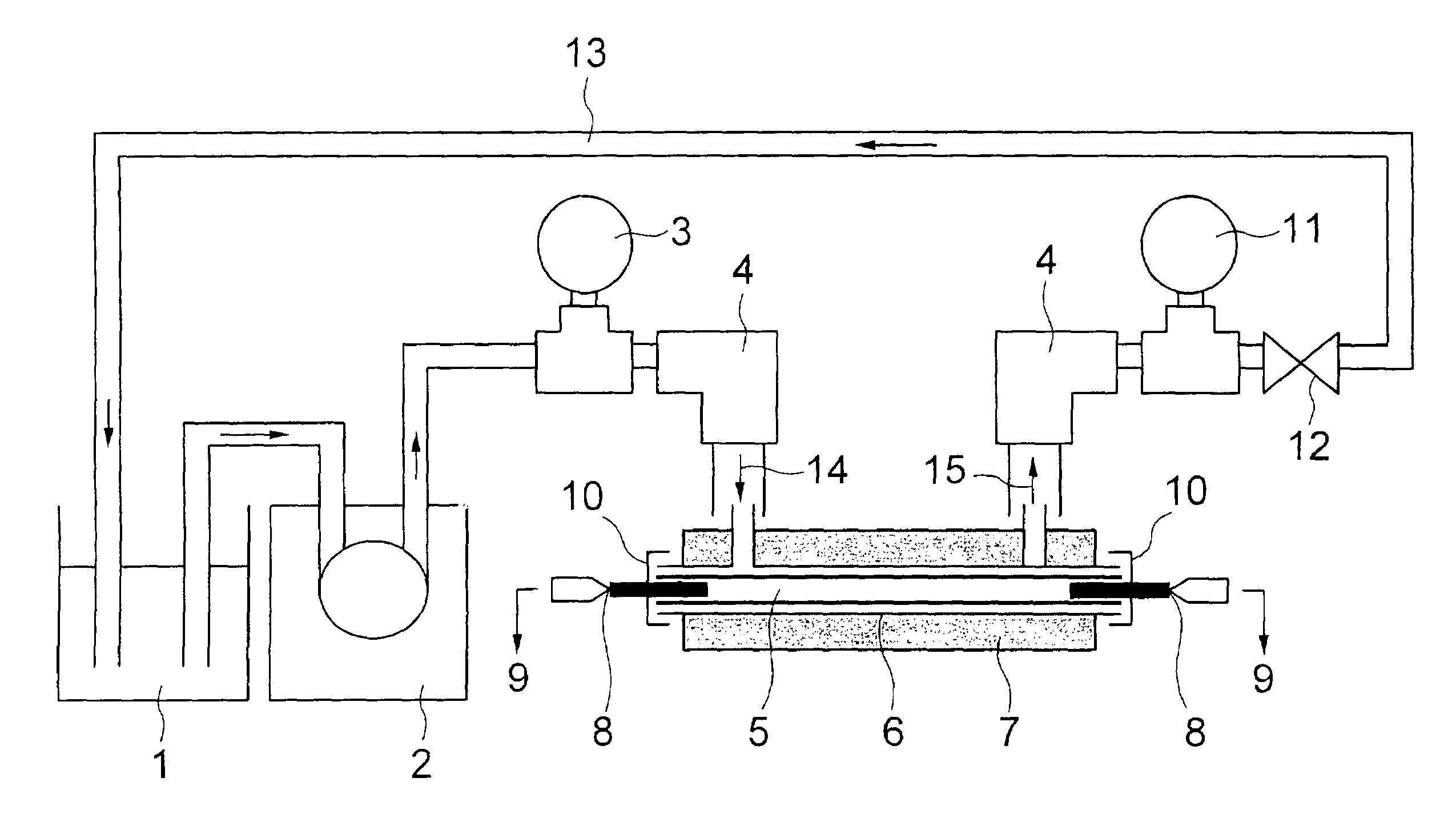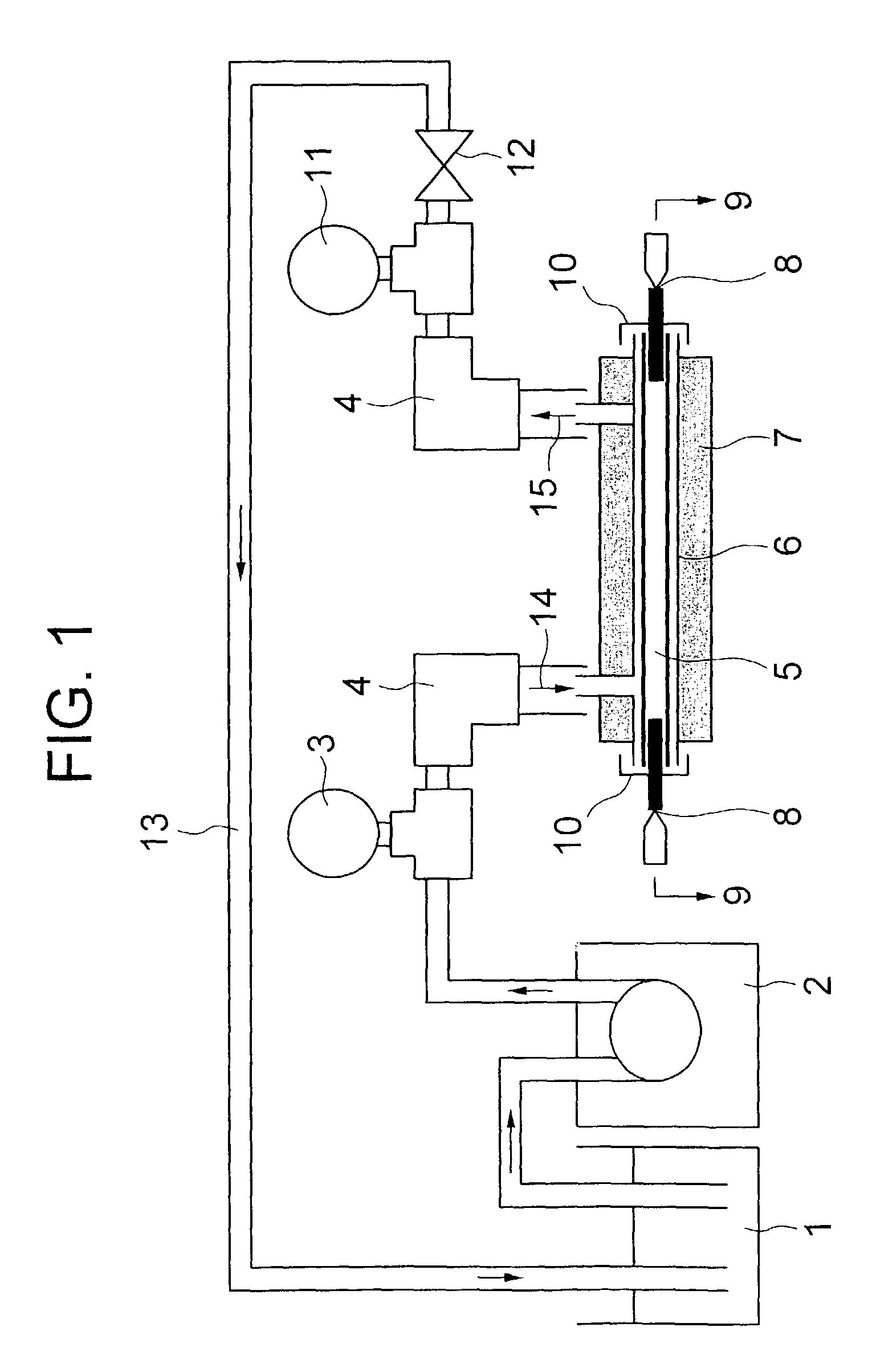Method for purifying suspended water by membrane filtration
a technology of membrane filtration and suspended water, which is applied in the direction of membrane filtration, separation process, separation, etc., can solve the problems of deterioration of permeability of membrane, hinderance to a stable operation of membrane filtration, and wide spread of membrane filtration methods, so as to improve filtration stability and reduce permeability deterioration
- Summary
- Abstract
- Description
- Claims
- Application Information
AI Technical Summary
Benefits of technology
Problems solved by technology
Method used
Image
Examples
example 1
[0052]A mixture of 20 parts by weight of high density polyethylene (SH800 from Asahi Kasei Corp.) and 80 parts by weight of diisodecyl phthalate (DIDP) was heated and mixed to a molten state (at 230° C.) in a twin screw extruder (TEM-35B-10 / 1V from Toshiba Machine Co., Ltd.). Then the above molten mixture was extruded through a circular ring hole for extrusion of molten material, having an outer diameter of 1.58 mm and an inner diameter of 0.83 mm, which is present in an extrusion face of a spinneret for hollow fiber formation, mounted at the extrusion exit in a head (230° C.) of the extruder tip. DIDP was discharged as a hollow part forming fluid through a round hole for injection of hollow part forming fluid, having 0.6 mm of diameter, which is present inside the circular ring hole for extrusion of molten material, and injected into a hollow part of the hollow fiber-like extrudate.
[0053]Hollow fiber-like extrudate extruded through the spinneret into air and was introduced into a l...
example 2
[0054]A mixture of 20 parts by weight of high density polyethylene (Hizex Million 030S from Mitsui Chemical Co., Ltd.) and 80 parts by weight of diisodecyl phthalate (DIDP) were heated and mixed to a molten state (at 230° C.) in a twin screw extruder (TEM-35B-10 / 1V from Toshiba Machine Co., Ltd.). Then said molten material was extruded through a circular ring hole for extrusion of molten material, having an outer diameter of 1.58 mm and an inner diameter of 0.83 mm, which is present in an extrusion face of a spinneret for hollow fiber formation, mounted at extrusion exit in a head (230° C.) of extruder tip. DIDP was discharged as a hollow part forming fluid through a round hole for injection of hollow part forming fluid, having a diameter of 0.6 mm, which is present inside the circular ring hole for extrusion of molten material, and injected into a hollow part of hollow fiber-like extrudate.
[0055]Hollow fiber-like extrudate extruded through the spinneret into air was introduced into...
example 3
[0056]A mixture of 25.5 parts by weight of pulverized silica (R-972 from Nippon Aerosil Co., Ltd.) and 50.5 parts by weight of dibutyl phthalate (DBP) were mixed in a Henschel mixer, then 24.0 parts by weight of high density polyethylene (SH800 from Asahi Kasei Corp.) were further added thereto and mixed again in the Henschel mixer. The mixture was pelletized using a twin screw extruder. Pellets thus obtained were melted and mixed in a twin screw extruder (at 220° C.). The said molten material was extruded through a circular ring hole for extrusion of molten material, having an outer diameter of 1.58 mm and an inner diameter of 0.83 mm, which is present in an extrusion face of a spinneret for hollow fiber formation, mounted at extrusion exit in a head (220° C.) of extruder tip. Nitrogen gas was discharged as a hollow part forming fluid through a round hole for injection of a hollow part forming fluid, having a diameter of 0.6 mm, which is present inside the circular ring hole for ex...
PUM
| Property | Measurement | Unit |
|---|---|---|
| pore diameter | aaaaa | aaaaa |
| pore diameter | aaaaa | aaaaa |
| pore diameter | aaaaa | aaaaa |
Abstract
Description
Claims
Application Information
 Login to View More
Login to View More - R&D
- Intellectual Property
- Life Sciences
- Materials
- Tech Scout
- Unparalleled Data Quality
- Higher Quality Content
- 60% Fewer Hallucinations
Browse by: Latest US Patents, China's latest patents, Technical Efficacy Thesaurus, Application Domain, Technology Topic, Popular Technical Reports.
© 2025 PatSnap. All rights reserved.Legal|Privacy policy|Modern Slavery Act Transparency Statement|Sitemap|About US| Contact US: help@patsnap.com



